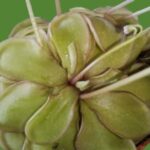As an Amazon Associate, this site earns commissions from qualifying purchases. For more details, click here.
Butterworts (pinguicula) are carnivorous plants that feed on insects and other small animals. If you have ever seen bugs stuck or eaten by one of these, you have probably wondered, are these plants toxic? Is it safe to have them at home? Those questions will all be answered here.
Butterworts are not poisonous to humans or pets. Their glands produce mucus to trap insects, but it is harmless to humans. Animals that eat butterworts may end up with an upset stomach but it will be temporary.
Are Butterworts Harmful to Humans?
Because butterworts kill their prey before eating them, it is understandable why some may think they are dangerous. But once you understand how these plants function, you will realize these concerns are unfounded.
Butterworts are harmless to people because their traps are only meant to catch insects. The mucus on their leaves will trap small prey, but it has no negative effect on humans and large animals.
First we need to take a closer look at how butterworts catch and eat bugs so we can understand why it poses no danger to anyone.
There are basically two types of butterworts (or pinguicula): tropical, which do not go dormant, and cold temperate butterworts which go through dormancy in winter. But all of them use basically the same method to catch and eat insects. This method is also what butterworts use to digest Value Grubs and fish food.
How Butterworts Catch Prey
Butterworts are often called flypaper plants because that is how their traps work. Their leaves have glands that secrete mucus which makes the surface sticky and greasy. If you have seen how sundews capture prey, you will have a good idea of how butterworts work. There are many similarities here.
The mucus has a sweet scent which attracts flies, gnats, and other bugs. When an insect tries to eat the mucus, it gets stuck on the leaf. Then it is only a matter of time before the pinguicula starts to eat it. The digestion process is similar to other carnivorous plants.
When a pitcher plant catches a frog for instance, it releases digestive enzymes to dissolve the animal. Butterworts do something similar. When an insect is caught on its leaves, the plant produces digestive juices to break the tissues and organs, leaving only its exoskeleton behind.
The mucus and digestive enzymes that butterworts produce are meant to catch insects and small animals. It does not contain any elements which are toxic to people and other animals.
What Happens if You Touch Butterworts?
You will not be harmed if you touch butterworts. Their mucus and digestive enzymes will leave a sticky mess on your finger, but you can wash it off.
The mucus (or mucilage) produced by its leaf glands are strong enough to trap small insects. But you can touch these and easily lift your finger up.
If you look closely at a pinguicula you will see droplets on its leaves. Those are the mucus which their glands spread throughout each leaf. These droplets make the plant look wet, which helps draw bugs looking for water.
When an insect tries to sip the mucus, it triggers a mechanism in the plant, causing it to release more mucus. The insect gets stuck and the more it tries to escape, the more mucus are released. When the prey is completely held down, digestion begins as the plant secretes digestive enzymes.
Both digestive enzymes and mucus are safe to touch. It will not cause skin irritation, pain or any discomfort. The worst part is your finger is covered in goo, but it is washable.
These digestive enzymes are strong enough to dissolve insect tissues, It will not injure or harm human skin. Some butterworts also curl their leaves so it can produce more mucus to trap insects, but it has no effect on people.
Butterworts like p. gigantea developed traps to compensate for the lack of nutrients in the soil. They can create food with photosynthesis, but these plants still require nutrients. Mexican pinguicula and other species grow on flatwoods, oak pine forests and mossy banks where nutrient rich insects abound, so they became prey.
The traps on a pinguicula are solely for insects, small bugs and sometimes even pollen. which makes them herbivorous and carnivorous. However, the digestive enzymes in butterworts do not contain elements which can digest a large animal.
Are Butterworts Poisonous to Cats?
Cats like to play with plants and sometimes eat them. If you have butterworts or other carnivorous plants at home, is your pet in any danger?
Butterworts are not toxic to cats. A cat that eats the plant might suffer indigestion but this is only for a short term. There are no known side effects from eating butterworts.
Of course if your cat has a sensitive stomach and prone to indigestion, you must not allow them to eat butterworts. In general though, eating pinguicula or any carnivorous plant is not going to harm your cat or dog for that matter.
This goes back to the point we made earlier about why butterworts became carnivores in the first place. They need nutrients, and their traps can only work on small insects. Their mucus and digestive enzymes are not potent enough to work on cats, dogs or other animals.
This is an important point. If you are feeding your butterworts, give it only small amounts of food Just a bit of Kaytee Mealworms is more than enough.
What happens if a cat eats several leaves including the mucus? Nothing serious except perhaps an upset stomach. If the amount is small enough there might be no reaction from your pet at all.
It is not clear why cats like to eat carnivorous plants, but it might have something to do with the mucus. There is still research going on but what is clear is that it does not hurt animals.
In fact, cats pose a greater danger to butterworts. Eating a few leaves could derail its growth or become even fatal depending how much of the plant is consumed.
Caring for Butterworts When You Have Pets
Hopefully it should be clear by now that butterworts are not poisonous to people or pets. You can keep them in your home without worry. But how can you prevent a pet from turning your pinguicula into dinner? Fortunately there are some things you can do.
- If you have an indoor cat, you can keep the plant outdoors. If you have a temperate pinguicula that grows naturally in your location, it is safe to keep it outside all year round.
- Place the plant in a dedicated room for your plants. Lock the door so your pet cannot get in. Do make sure the room has enough sunlight, water and the right temperature to keep the plant healthy.
- Keep your pet busy. There are many toys for cats available to keep them occupied.
- Cats do not like the smell of citrus. Spray the leaves and it should deter them. This might not work for other animals though.
- Another option is to place the plant on a high shelf. However this can make it harder to feed your plant.
Here are some more tips on how to grow your butterworts. Properly taken care of, your plants will grow faster and live longer.
- Learn as much about the butterworts variant you want. Tropical butterworts for example, prefer 60-75 F (15-25 C) temperature.
- Humidity has little effect on tropical butterworts. A bit of humidity is fine but too much will cause its roots to decay.
- Just like other carnivorous plants, pinguicula grows best in moist soil. Do not wet the soil too much because it will lead to rotting.
- The best soil is peat moss and perlite or perlite and sphagnum moss. You can use a mix ratio of 1:1 or 2:1.
- Tropical butterworts prefer direct sunlight in the morning and partial light around noon. Do not expose it to intense heat.
Conclusion
Butterworts are predatory plants, but for humans and pets they are safe. As we have pointed out here, your pinguicula is in greater risk from pets than the other way around. If you are new to carnivorous plant growing, there is nothing to worry about.

My fascination with carnivorous plants began many, many years ago with Venus Fly Traps. Now I am more than happy to impart what I know with other enthusiasts and those who are curious about meat eating plants.



